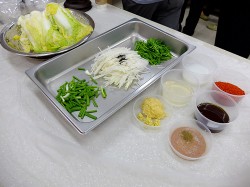Patricia Paskov | 02.04.2013
Koreans consume a whopping 2 million tons of kimchi a year, and they’re not the only ones.[i] As the raw food craze takes off, the fermented cabbage dish is spreading beyond the Korean peninsula to win over Western foodies and health-nuts alike. Popularized in part by Sandor Katz, self-proclaimed fermentation fetishist, kimchi is now widely consumed?from the Tennessee countryside Mr. Katz calls home, to trendy restaurants in New York and L.A. Yet, for Koreans, kimchi is far from a hot, new trend: it’s a matter of survival, tradition and cultural identity.
Kimchi originated in Korea during the Three Kingdoms period (1st century BC to the 7th century AD). By that time, families had long used preservation methods to keep a constant food supply for their families during the long, harsh winters. So, when the first cabbage arrived to Korea in 2030 B.C., families turned to fermentation to preserve it. In the 16th century, the first chili peppers arrived from the Americas giving kimchi its signature spicy flair, and the recipe was complete. A blend of cabbage, garlic, ginger, hot red chili peppers, vegetables, fish sauce and often seafood, kimchi has since established itself as a Korean culinary staple.

Indeed, kimchi is the one food that most Koreans simply “cannot live without.”[ii] Whether served in a stew, atop fried rice or on its own, it seems to make its way into every meal of the day. In autumn, South Korean employers even give their workers a customary “kimchi bonus,” helping to subsidize the ingredients for their annual kimchi supply.[iii] Women are traditionally the ones to prepare the dish, throwing in a pinch of this and a handful of that to yield a flavor distinctive to each family. Even with the growing influence of industrially produced foods?including imports of processed kimchi from China?the majority of Koreans continue to prepare kimchi in their very own kitchens.
The importance of kimchi was underscored in 2010 when torrential rains and typhoons destroyed that year’s crop of napa cabbage, the variety most commonly used for kimchi.[iv] South Korea’s cabbage shortage led to a sudden price spike and a full-blown cabbage crisis. In light of the crop’s central importance, government officials were forced to respond quickly, temporarily suspending import tariffs to stabilize prices and satisfy the nation’s demand for cabbage and, of course, kimchi. The South Korean agricultural sector managed to recover from the cabbage crisis of 2010, and Korean farmers continue to furnish most of the cabbage consumed in the country. But farmers face many challenges.
Today, dazzling cities encroach on rural farming regions and the government sees domestic agriculture as a low priority?instead pursuing policies such as the recently-signed US-Korea Free Trade Agreement (FTA). Experts and Korean social movements argue the FTA will destroy farmer livelihoods, resulting in a devastating loss of South Korea’s peasant culture.[v] Amidst these economic and agricultural transformations, however, kimchi’s fourteen-century-old tradition remains a constant cultural force. Simple but significant, kimchi continues to tie Koreans back to their roots, fermenting tradition and perhaps even struggles for food sovereignty.
BAECHU (CABBAGE) KIMCHI
From Wild Fermentation by Sandor Katz
Ingredients:

Sea salt
1 pound Chinese cabbage
1 daikon radish or a few red radishes
1-2 carrots
1-2 onions, leeks, scallions, or shallots
3-4 cloves of garlic
3-4 hot red chilies
3 tablespoons ginger root
Preparation:
1) Mix a brine of 4 cups of water and 4 tablespoons of salt. Stir well to thoroughly dissolve salt. The brine should taste good and salty.
2) Coarsely chop the cabbage, then slice the radish and carrots. Cover the vegetables with a plate or other weight to keep them submerged in the brine, allowing them to soak until soft (a few hours or overnight). Add other vegetables to the brine ? snow peas, seaweeds, Jerusalem artichokes, anything you like.
3) Prepare the spices: grate the ginger, chop the garlic and onion, remove seeds from the chilies and chop or crush, or throw them in whole. Mix spices into a paste.
4) Drain brine off vegetables, reserving the brine. If the vegetables taste too salty, rinse them. Otherwise, if not salty enough, sprinkle with a couple of teaspoons of salt and mix.
5) Mix the vegetables with the ginger-chili-onion-garlic paste. Mix everything together thoroughly and stuff into a clean quart-size liter jar. Pack tightly into jar, pressing down vegetables until the brine rises. If necessary, add the reserved vegetable-soaking brine. Weight the vegetables down with a weighted jar or bag.
6) Ferment in a warm area. After about a week of fermentation, move the kimchi to the refrigerator. An alternative, more traditional method is to ferment the kimchi for a longer period of time in a cool spot ? clay pots placed in the ground, a cellar, etc.






![]() :Information:News
:Information:News











